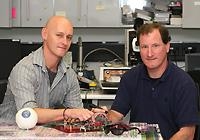Funds put bionic eye in sight
A functioning bionic eye is a step closer to reality after the federal government awarded $42 million in funding to a consortium including leading UNSW researchers.
A functioning bionic eye is a step closer to reality after the federal government awarded $42 million in funding to a consortium including leading UNSW researchers.

A bionic eye capable of restoring vision to the blind is a step closer to reality after the federal government awarded $42 million in funding to a consortium including leading researchers from UNSW.
Federal Minister of Innovation, Industry, Science and Research, Senator Kim Carr, has announced the funding will go to Bionic Vision Australia (BVA) to further development of a functioning bionic eye.
BVA is a consortium including the University of Melbourne, the University of New South Wales, the Bionic Ear Institute, Centre for Eye Research Australia and the Victoria Research Laboratory of NICTA. The project is also supported by researchers from the Australian National University and the University of Western Sydney.
Professor Nigel Lovell is leading UNSW's bionic eye research at the Graduate School of Biomedical Engineering with Associate Professor Gregg Suaning.
Professor Lovell said the funding meant life-changing bionic vision was now a step closer.
"Researchers at UNSW have been working on the development of a bionic eye for 10 years. The BVA consortium brought together the leading scientists and biomedical engineers in the country to advance this vitally important project and this funding will give us the resources to make a huge leap forward," he said.
BVA Chairman, Professor Emeritus David Penington AC said the consortium was honoured to be selected by the Australian Research Council for funding.
"This opportunity will allow our team to use its outstanding know-how and expertise to develop a functioning retinal implant that will deliver profound benefits to sufferers of degenerative vision loss such as retinitis pigmentosa and age-related macular degeneration," he said.
The bionic eye under development uses a video camera fixed to a patient's glasses to capture images which are translated into electrical impulses that stimulate electrodes inserted into the retina. The impulses stimulate the same area of the retina usually activated by visual cues, and over time the patient learns to interpret these nerve signals as useful vision.
The government awarded a further $8 million to a second team from Monash University and Melbourne's Alfred Hospital.
Senator Carr said the funding meant Australia had the potential to give and restore sight to thousands of people around the world.
"I congratulate both teams for receiving this funding and I look forward to watching their research evolve into the development of a bionic eye, which will ensure Australia maintains its position as a world leader in bionics," he said.
Media Contact: Professor Nigel Lovell | +61 2 9385 3922 | n.lovell@unsw.edu.au
UNSW Media Office: Peter Trute | +61 2 9385 1933 | p.trute@unsw.edu.au
Watch a video on UNSW bionic eye research here